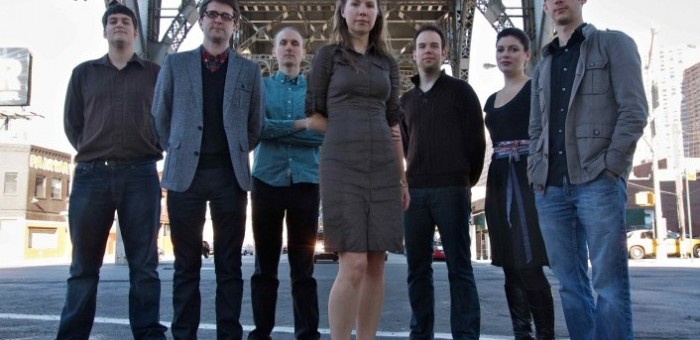Dec 9, 2025 12:28 PM
In Memoriam: Gordon Goodwin, 1954–2025
Gordon Goodwin, an award-winning saxophonist, pianist, bandleader, composer and arranger, died Dec. 8 in Los Angeles.…

The Wet Ink Ensemble payed tribute to avant-garde reedist Anthony Braxton on Jan. 20 at National Sawdust in Brooklyn, New York.
(Photo: Courtesy of the artist)How do you solve the age-old problem of the classical/jazz divide? Or for that matter, how do you approach the more actual problem of a contemporary music ensemble playing the work of a jazz master? When the musicians are New York’s talented collective Wet Ink and the composer is the visionary Anthony Braxton, you do it by taking small steps in as standard a shoe as possible.
Four of the seven members of the New York City-based Wet Ink Ensemble—joined by eight guests—rose to the challenge Jan. 20 at National Sawdust, a posh contemporary music venue that opened in October in the Williamsburg section of Brooklyn. The performance was a part of the ensemble’s ongoing series of “portrait” concerts focusing on individual composers. Past portrait concerts have featured the work of Peter Ablinger and Katharina Rosenberger.
That opener was “Composition No. 58,” included on Braxton’s album Creative Orchestra Music 1976 (Arista), one of the greatest suprises in the extensive Braxton discography. It’s an exhilarating piece of brisk parade music that falls into abstraction before rediscovering itself within the space of a few minutes. The ensemble stayed true to the piece, playing it without irony and giving it a nice New Orleans swing. As the goup moved on through “Compositions No. 116” and “131,” pianist Eric Wubbels held sway over the group with tightly rendered conducting.
After that, Wubbels moved to the piano, replacing the fine soprano Kate Soper for a lovely take on “Composition No. 56.” Wubbels and saxophonist Alex Mincek easily called to mind Braxton’s duo recording of the piece with Marilyn Crispell. (It should be noted that Wet Ink’s Mincek, Soper and Wubbels are also among the city’s most exciting under-40ish composers.)
The near unison piano and saxophone lines were wonderfully familiar against the surprisingly loud and angular rhythm set by bassist Greg Chudzik and drummer Ian Antonio. Chudzik later played a deep and slow duet with Jeff Snyder, stationed behind a table of electronic devices, creating the most abstract setting of the evening. Still, the ensemble didn’t shy away from jazziness, with trombonist Jacob Garchik laying a sweet plungered solo atop the sound bed. By the time the full ensemble was in play, the music had advanced two or three Braxton decades, calling to mind his great 12+1tet of the 2000s.
The final section of the night was also the longest, giving the group an opportunity to melt into Braxton’s Ghost Trance Music, perhaps his most successful strategy to date for structured improvisation, with Soper shining among the instrumentalists. Building from the long, sinewy lines of “Composition No. 227,” the performers swapped hand signals to cue smaller pieces to play within the larger framework, with players occasionally stepping out on their own (as in a great solo by trumpeter Peter Evans).
After the pace was set, bassoonist Sara Schoenbeck was the first to signal a sub-section, initiating a brief duet with trumpeter Nate Wooley (both of whom have played in Braxton ensembles) and then another with Mincek while Soper and Wet Ink violinist Joshua Modney found their own rivulet to travel, all against an almost comical electronics and prepared piano beat and an underlying rhythm from the drum kit.
Ultimately, of course, it’s not the file-under labels that matter in such music but the collective experience of the ensemble, and in Wet Ink (a group that has included Braxton’s music in their performancers in the past) the concert had a strong working unit as a core.
As with the fantastic Italian Instabile Orchestra’s record with Braxton (Creative Orchestra— Bolzano 2007) or the Orchestra Della Toscana playing Butch Morris’ conducted improvizations (1999’s Holy Sea) a special sort of ensemble is demanded to take music with loose rules and make it tight. Wet Ink and guests did so more than respectably.

Goodwin was one of the most acclaimed, successful and influential jazz musicians of his generation.
Dec 9, 2025 12:28 PM
Gordon Goodwin, an award-winning saxophonist, pianist, bandleader, composer and arranger, died Dec. 8 in Los Angeles.…

Nov 13, 2025 10:00 AM
For results of DownBeat’s 90th Annual Readers Poll, complete with feature articles from our December 2025 issue,…

Flea has returned to his first instrument — the trumpet — and assembled a dream band of jazz musicians to record a new album.
Dec 2, 2025 2:01 AM
After a nearly five-decade career as one of his generation’s defining rock bassists, Flea has returned to his first…

To see the complete list of nominations for the 2026 Grammy Awards, go to grammy.com.
Nov 11, 2025 12:35 PM
The nominations for the 2026 Grammy Awards are in, with plenty to smile about for the worlds of jazz, blues and beyond.…

“It’s a pleasure and an honor to interpret the music of Oscar Peterson in his native city,” said Jim Doxas in regard to celebrating the Canadian legend. “He traveled the world, but never forgot Montreal.”
Nov 18, 2025 12:16 PM
In the pantheon of jazz luminaries, few shine as brightly, or swing as hard, as Oscar Peterson. A century ago, a…